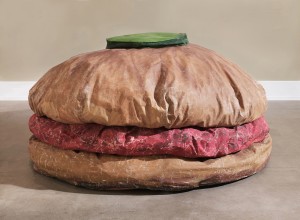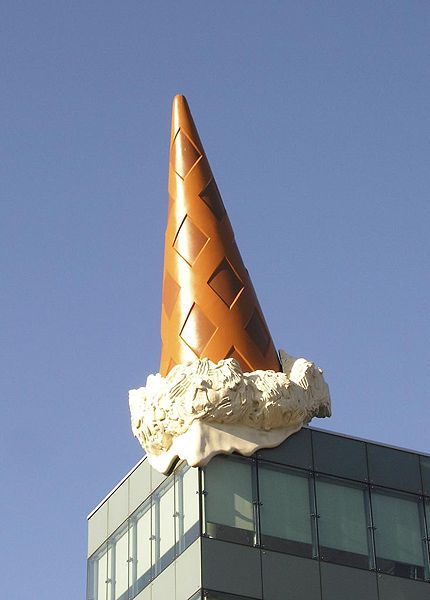In 1967, Claes Oldenburg’s big lovable burger sculpture called Floor Burger (1962), was not necessarily well received at the Art Gallery of Ontario in Toronto. People stood in front of the gallery with signs reading ‘Don’t Burger Up Our Gallery,’” says Shiralee Hudson Hill, an interpretive planner at the gallery.
According to Art News, “Today, “the burger” is one of the museum’s most popular works. And the painted canvas sculpture, which recently underwent a major restoration, will be among the works included in the show “Claes Oldenburg: The Street and the Store,” opening at the Museum of Modern Art this weekend.”
“Floor Burger’s form is very well-constructed,” says AGO conservator Sherry Phillips. “Oldenburg’s first wife, Patty, sewed all the pieces together.” But they needed to address the inside of the sculpture. “The burger’s stuffing—chunks of foam and, surprisingly, cardboard ice-cream cartons—has fared well, but the pieces shifted, leaving the sculpture with an uneven appearance,” Phillips explains. “We used archival images of the piece for comparison, and gently pushed and pulled the stuffing to create a better-defined ‘burger’ shape.”
Oldenburg admits, “I was more concerned with the effect of the piece as I was making it rather than its future conservation,” adding, “We were careful to use high-grade materials, but still the result is a lot of people work in art restoration now because works from that period are starting to need attention.” The 84-year-old artist explains why he decided to use ice-cream cartons as stuffing. “I started with the foam, but found it was weighing the sculpture down,” he says, “so we used the empty boxes to make it lighter.”
Many urban legends about Floor Burger circulate at the AGO, including early reports of visitors jumping on it, expecting it to be cushiony like a beanbag chair. There are also tales about the pickle that sits on the burger’s bun. According to one story, the pickle disappeared in the early ’70s, and Oldenburg flew to Toronto with a replacement, claiming it was a travel pillow to get it through customs. “The pickle is made differently from the rest of Floor Burger,” says Phillips. “There’s a different type of paint, so it could have been a later addition or substitution.”
Oldenburg laughs upon hearing this. “That sounds like it could be true,” he says. “But like a lot of things, I can’t remember for sure. I do recall that the sides of the pickle are covered with a shinier paint than the rest, so it looks wet like a pickle. But that is still a very convincing story. I’ll have to look in my diaries.”
Oldenburg is best known for his public art installations typically featuring very large replicas of everyday objects. Another theme in his work is soft sculpture versions of everyday objects. Many of his works were made in collaboration with his wife of 32 years, Coosje van Bruggen, who died in 2009.
Related articles













Comments (0)